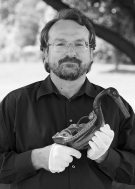Repatriation of Native American cultural items involves complex issues of religion, property law, provenance, and indigenous rights. 3D digital replication of objects is emerging as an approach that allows museums and tribes to manage their sometimes conflicting interests and work together toward both educational and ceremonial goals. Hollinger will describe some of the Smithsonian’s recent collaborations with tribes on 3D replication projects.
Cosponsored by Penn Museum and the Price Lab for Digital Humanities.
 Eric Hollinger is a Tribal Liaison for the Repatriation Office of the Smithsonian’s National Museum of Natural History. He works with Native Alaskans and tribes throughout the United States on repatriation issues, particularly with 3D digitization and replication for cultural restoration. The Repatriation Office was established in 1991 to implement the statutory requirements of the NMAI Act, which asserts the right of Native American, Alaska Native and Native Hawaiian peoples to determine the disposition of culturally affiliated human remains, funerary objects, sacred objects, and objects of cultural patrimony currently in the collections of the Smithsonian Institution. The Smithsonian regularly works with several indigenous clans and communities to apply 3D digitization and replication technologies to cultural preservation and restoration issues. As Tribal Liaison, Hollinger continues this effort, most recently with the Tlingit tribe of southeastern Alaska. Through collaborative efforts, Hollinger has been able to scan repatriated objects and archive them digitally, as well as find ways to tell the story about the repatriation of objects and their original roles in their communities. Hollinger's team has been able to recreate objects out of similar materials and most recently, they used 3D printing technology to bring 200 year old materials back to life. Hollinger's work with the Tlingit tribe marks the first museum-led 3D replication of repatriated sacred objects and could prove precedent-setting for cultural institutions and indigenous groups alike.
Eric Hollinger is a Tribal Liaison for the Repatriation Office of the Smithsonian’s National Museum of Natural History. He works with Native Alaskans and tribes throughout the United States on repatriation issues, particularly with 3D digitization and replication for cultural restoration. The Repatriation Office was established in 1991 to implement the statutory requirements of the NMAI Act, which asserts the right of Native American, Alaska Native and Native Hawaiian peoples to determine the disposition of culturally affiliated human remains, funerary objects, sacred objects, and objects of cultural patrimony currently in the collections of the Smithsonian Institution. The Smithsonian regularly works with several indigenous clans and communities to apply 3D digitization and replication technologies to cultural preservation and restoration issues. As Tribal Liaison, Hollinger continues this effort, most recently with the Tlingit tribe of southeastern Alaska. Through collaborative efforts, Hollinger has been able to scan repatriated objects and archive them digitally, as well as find ways to tell the story about the repatriation of objects and their original roles in their communities. Hollinger's team has been able to recreate objects out of similar materials and most recently, they used 3D printing technology to bring 200 year old materials back to life. Hollinger's work with the Tlingit tribe marks the first museum-led 3D replication of repatriated sacred objects and could prove precedent-setting for cultural institutions and indigenous groups alike.



